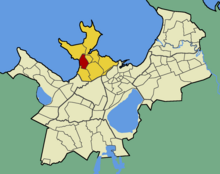Pelguranna
Pelguranna (in German Refuge Beach ) is a district ( Estonian asum ) of the Estonian capital Tallinn . It is located in the Põhja-Tallinn district ("North Tallinn"). In the west it borders on the Bay of Kopli ( Kopli laht ).
Description and history
The city district has 15,207 inhabitants (as of May 1, 2010).
In the 18th century the area consisted of meadows and pastureland for the Tallinn population as well as larger areas of forest. There were also dubious people and criminals hiding there, which is where the name of the area comes from.
With the construction of the railway line between Tallinn and the Baltic Sea port of Paldiski (1869/70), industrial plants settled in Pelguranna. Workers' apartments were built. Above all, the Baltic Cotton Factory ( Balti Puuvilla Ketramise ja Kudumise Vabrik ), one of the largest textile factories of the time in the Baltic States , drew numerous workers to the area.
Initially, simple wooden houses were built. In the interwar period , newer, modern residential complexes from the housing cooperative Oma Kolde were added. Between 1923 and 1926, she had eight two-story residential complexes built in massive construction. The architects Herbert Johanson and Eugen Habermann based themselves on the example of Dresden - Hellerau .
In autumn 1923 the Säde cinema was inaugurated in Pelguranna . It was one of the leading silent movie theaters in the city. From 1927 the cinema was called Ilo , from 1930 Lux before it ceased operations.
In the early 1930s the house of prayer of the Seventh-day Adventists was built in Pelguranna . The building was confiscated by the Red Army during the Soviet occupation of Estonia . Today it is the district's cultural center.
The later residential buildings in the district were mainly built from the 1950s, during the Soviet occupation of Estonia. Most of them have been made of prefabricated panels since the 1960s . Most of these houses are five-story. There are also high-rise buildings with nine or fourteen floors. Despite everything, the district has retained its green character. The school for the deaf with recognized Estonian sign language and the hearing impaired can be seen there.
Pelguranna includes the sandy beach of Stroomi rand on the shores of the Baltic Sea, popular among the people of Tallinn . It is called Stromka by the Russian-speaking population .
literature
- Robert Nerman: Pelgulinn. Kultuurikeskkonna kujunemine ja areng. Tallinn 2000, ISBN 9985-60-690-6
Web links
Individual evidence
- ↑ Archived copy ( Memento of the original from May 17, 2011 in the Internet Archive ) Info: The archive link was inserted automatically and has not yet been checked. Please check the original and archive link according to the instructions and then remove this notice.
Coordinates: 59 ° 27 ' N , 24 ° 41' E

